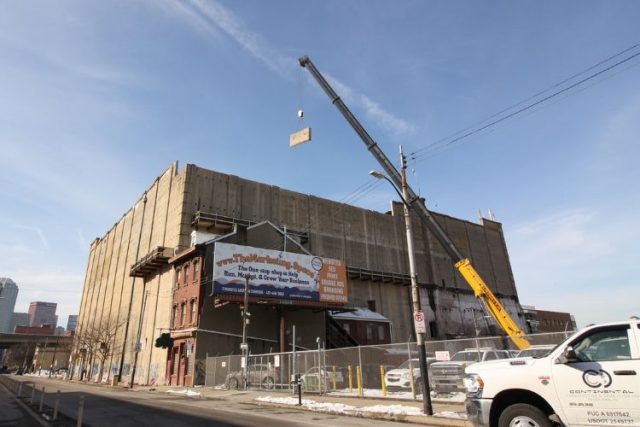By David S. Rotenstein
The Real Luck Café, known by most folks as “Lucky’s,” may be the most aptly named bar in Pittsburgh.
In 2019, the Pittsburgh Planning Commission approved a new development located next door to the gritty Strip District gay bar at 1519 Penn Ave. The developer’s plans included buying Lucky’s to make it simpler and cheaper to demolish the adjacent seven-story former cold storage structure (known as the Wholey’s fish building).
But the bar’s owner rebuffed the developer’s offer and set the stage for one of the city’s most spectacular demolitions played out in slow motion over several months this year.

Demolition of the Federal Cold Storage Company building as section of a large concrete wall is lifted over Lucky’s in February. Photo by David S. Rotenstein.
When the new development at 1501 Penn is done, passersby might be tempted to compare Lucky’s to other holdout buildings or “spite houses”: architectural anachronisms around which new development sprouted because owners refused to sell.
The Lucky’s story isn’t so simple.
Its history and endurance are an authentic Pittsburgh tale. The club has survived a series of potential catastrophes leading up to the redevelopment, including the Covid pandemic and seismic shifts in gay club life.
The jury is still out on whether Lucky’s can survive the Strip’s transformation from an industrial working-class neighborhood into a trendy space with high-rise office towers, high-tech firms, and high-end housing.
This is Lucky’s story.
The giant refrigerator
Before 1930, the building where Lucky’s is located was one of five brick row houses along the north side of Penn in land once owned by Pittsburgh’s German Catholic High School.
In the late 1920s, the Pennsylvania Railroad bought several Strip District blocks to expand and modernize the city’s produce terminal. In 1930, the Cleveland-based City Ice and Fuel Co. created a Pittsburgh subsidiary, the Federal Cold Storage Co., and broke ground on a seven-story concrete warehouse on a parcel of land it bought from the Pennsylvania Railroad.
The Federal Cold Storage Co. monolith became the third-largest cold storage building in North America and a prominent visual landmark in a Strip District block bounded by 15th Street, Smallman Street and Penn Avenue. Its walls were 3 feet thick and had three layers: an outer concrete layer, a layer of powdered cork obtained from the nearby Armstrong Cork Co. plant and an inner concrete wall.
To retain its cool temperature, the warehouse had no windows. The Pittsburgh Press described it as a “vast concrete refrigerator.”
The building became a regional food distribution hub because of its proximity to the Pennsylvania Railroad’s produce terminal. It stored mostly produce but also poultry and other perishable foods for area wholesalers and markets. A two-story annex functioned as a refrigeration and ice plant, drawing water from the Pittsburgh aquifer and producing ice that was sold throughout the city.
In 1980, the Strip District fish retailer and wholesaler Robert Wholey & Co. bought the building and affixed a large illuminated fish on one of the mammoth building’s blank facades.
Over the next 40 years, Pittsburghers fondly called it the “Wholey Building,” and the fish became a beloved part of the skyline. In the 1990s, acclaimed local artist Scott Fertig installed a series of murals in the annex’s windows.
In its 80 years as a cold storage warehouse, dairy company Borden rented space for its Pittsburgh operations. The national corporation was the building’s biggest tenant when Wholey’s bought it, according to Jim Wholey. “We used all the floors, but for the distribution business, we used roughly about two floors and the other five were used for public storage,” he says.
In 2013, Wholey’s began looking for a buyer for the warehouse. After several aborted redevelopment plans, New York-based developer JMC Holdings bought the property in 2018 and created an LLC, 1501 Penn Owner, to develop it. Negotiations with the Pittsburgh Planning Commission and Strip District neighborhood organizations yielded a plan for a new mixed-use development featuring four glass-clad office towers, the tallest rising to 23 stories.
Before the new development could be raised, the cold storage building had to be razed.
That’s when the developer approached Nancy Pribich, the owner of Lucky’s, with an offer to buy the property. She declined, setting up a visual spectacle involving a huge crane removing massive concrete blocks from the building and swinging them over the bar before being lowered to be crushed into rubble.
Mobsters on the block
Lucky’s occupies a narrow three-story brick building. Built in 1869, its first owner was a German jeweler named Gabriel Weisser. After Weisser died in 1890, his son continued selling jewelry there for about a decade. The family sold the property in 1913.

Lucky’s, c. 1990. Photo courtesy of the Pittsburgh History & Landmarks Foundation.
After a series of stores and bars had occupied the space, Ralph and Victoria Blakeley bought the building in 1951. Ralph was a small-time mobster with a long arrest record for gambling and assaults. The couple lived two blocks down in the 1700 block of Penn Avenue.
Soon after the purchase, Victoria applied for a liquor license to open a bar at 1519 Penn. Her husband’s long criminal record created problems, but she was able to open the Shamrock Café at the end of 1952.
Victoria Blakeley died in 1989. Robert “Lucky” Johns and three partners bought the Shamrock Café in 1990. The next year, Nancy Pribich bought out Johns’ three partners and in 2004 she became its sole owner.
Johns had become a Pittsburgh gay culture icon by that time. He built a nightclub empire that included some of the city’s pioneering gay bars: the Transportation Club, House of Tilden and Traveler’s Social Club. The Northside native started out tending bar in some of Pittsburgh’s mob-owned East End establishments, writes Harrison Apple in their 2020 doctoral dissertation about Johns, who died in 2014.
The pairing of an old 1950s-era bar sporting a large shamrock over its door and a bar owner nicknamed Lucky’s was the perfect combination. Pribich recalls that they originally named it the Real Luck Café to bolster their spirits as they rehabilitated the rundown bar. It didn’t take long for the name to be shortened to “Lucky’s.”

Lucky’s at night. Photo by David S. Rotenstein.
“It was a coincidence that a guy that was in business with me, Robert Johns, his nickname was Lucky,” Pribich says. “So I think maybe a lot of people assumed that we named it after him but we did not.”
Apple, a co-founder of the Pittsburgh Queer History Project and curator of the 2014 exhibit “Lucky After Dark,” thinks the situation is a lot more complicated than that.
They described it in an email as a “both/and situation,” i.e., “it conveniently references both the past and future looking story you were told, and Lucky, being very well-known to most of gay Pittsburgh, was identified with the bar and the bar with him.”
Ignore all the rumors
“Ignore all the rumors about the demolition of the property next door,” Lucky’s posted on its Facebook page in March. “We are still open still going strong and will be there to welcome our new neighbors when the project is all completed.”

View of the demolition and Lucky’s from the Hill District. Photo by David S. Rotenstein.
Chris Deppoliti, a managing director with the Acram Group (formerly JMC Holdings), explained that his company offered to buy Lucky’s to make the demolition easier. “We did make an offer,” he says. “We didn’t really push too hard to purchase the lot.”
Deppoliti explains that acquiring the lot would have been a logistical benefit.
Unable to buy Lucky’s, Acram got a $1 million grant from the state of Pennsylvania to help pay for the cold storage building demolition. The money helped to pay for the slow-motion demolition that has captivated Strip District workers and residents.
“We had protection over the bar, this big piece of machinery would saw-cut sections in various sizes and those would get picked with a crane down to the ground,” Deppoliti says.
One demolition worker on the site who declined to give his name says the bigger pieces weighed about 67,000 pounds with smaller section about 27,000 pounds.

Demolition of the Federal Cold Storage Company building and Lucky’s in December 2021. Photo by David S. Rotenstein.
The rumors of the bar’s premature demise irritate Pribich. She says that since the demolition began, the bar gets several calls a week, each of them some version of, “Are yinz still open? We heard you were closed.”
The bar survived the first stage of demolition and suffered only minor damage to its roof from falling debris. The Post-Gazette reported that Acram had deployed seismic sensors throughout the vicinity to monitor vibrations. One Lucky’s employee said that there was a sensor in the basement. They also said that before demolition began, Acram engineers fully surveyed the building to document its conditions.
Holdout or survivor?
Many of Pittsburgh’s gay bars succumbed to pandemic restrictions, changes in gay club culture and development, including Cruz, which was located nearby on Smallman Street. A redevelopment project displaced it and a parking deck now occupies the site.
In the 1990s, Lucky’s was sort of a bookend in a string of popular gay bars stretching from Downtown to the Strip. These included Pegasus on Liberty Avenue, which closed in 2009.
As members of the LGBTQ community put “For Sale” signs on their closets and began socializing in more open environments, redevelopment projects and the Pittsburgh Cultural Trust’s campaign to eradicate one of the city’s oldest red-light districts took their toll on gay nightlife.
Lucky’s may be best known for its nude male dancers in the upstairs bar and the overwhelming cigarette smell that wafts down Penn Avenue from its open door. Its story includes being one of the city’s testing sites during the AIDS epidemic and its role as a community benevolent organization.
Pribich didn’t want to talk about why so many other Pittsburgh gay bars have closed in recent years. She did, however, want to explain what makes Lucky’s a landmark institution. Her explanation underscores how important Lucky’s is not only to Pittsburgh gay culture, but to the city at large.

Lucky’s shamrock sign. Photo by David S. Rotenstein.
“We’re open every day, 365 days a year. We never close. Christmas, we give free food out. Thanksgiving, we give free dinner out. Easter, we give free dinners out,” she says.
Unlike other bars that offer food spreads during happy hours, Pribich began offering food to young gay men whose families turned them away during the holidays.
“We always did that for gay people who had nowhere to go,” Pribich says.
Pribich also welcomed unhoused people living nearby into the bar. “A lot of times we started getting a lot of straight people who would come in who had no place to go.” These included people living beneath the 16th Street Bridge. “They would come and we actually fed them all, a lot, quite a bit.”
Pribich insists that Lucky’s will never face the same fate that her former competitors and holiday meal patrons experienced: displacement and the loss of a home.
“We plan on not going anywhere at this point. We’re not planning on selling it, tearing it down, nothing at this point,” Pribich says.
“I have no idea what’s in the future but right now in the near future, we have no plans on going anywhere.”








